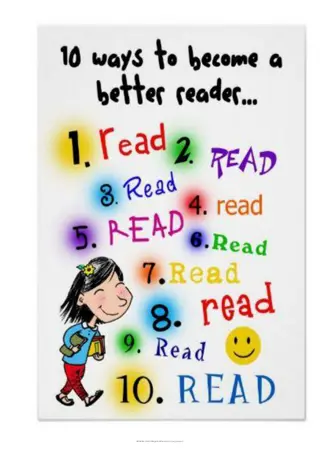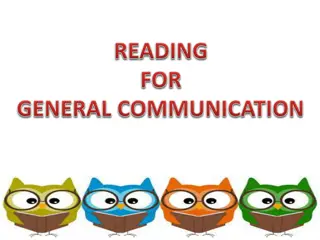Understanding Reading Abilities in Deaf/Hard of Hearing Children
Monica Kleekamp discusses the delayed reading abilities of children who are deaf/hard of hearing and explores the correlation between reading levels and phonological awareness. Different approaches to reading instruction and research questions on reading strategies, narrative comprehension, and impact of deviations on comprehension are also highlighted. The study involves six readers with severe to profound sensorineural hearing loss, focusing on their narrative comprehension and retelling abilities.
Download Presentation

Please find below an Image/Link to download the presentation.
The content on the website is provided AS IS for your information and personal use only. It may not be sold, licensed, or shared on other websites without obtaining consent from the author. Download presentation by click this link. If you encounter any issues during the download, it is possible that the publisher has removed the file from their server.
E N D
Presentation Transcript
Monica C. Kleekamp, M.S., CCC-SLP Fontbonne University Professional Forum: Serving Children Who Are D/HH in Inclusive Settings May 5th, 2017
Monica Kleekamp has no relevant financial or nonfinancial relationships to disclose.
Children who are deaf/hard of hearing demonstrate delayed reading abilities 4thgrade reading level (Albertini & Mayer, 2010; Mayer, 2007) Belief: Lower reading abilities correlate with impoverished phonological awareness Educational instruction phonemic awareness Vocabulary knowledge; stronger predictor (Kyle & Harris, 2006; 2011).
Approaches to reading: A. Skills-based Breakdown of a whole into parts (Beatty & Care, 2009) Emphasis on what text looks and sounds like Word Level Text Comprehension B. Holistic/whole language Multilayered circle with semantics at the center (Y. Goodman, Watson & Burke, 2005). Active meaning-making process between reader and text All language cuing systems support meaning
Research questions: 1. What reading strategies can readers identify? 2. To what extent does each reader utilize the graphophonic, syntactic and semantic language cuing systems while reading? 3. Which reading strategies do readers select and use during the reading process?
Research questions: 4. What are the narrative comprehension and retelling abilities of each reader? 5. How do readers identify the impact deviations from the text have on comprehension?
Participants 6 readers (3 boys, 3 girls), ages 11-14 Severe to profound sensorineural hearing loss Used listening and spoken language All bilateral cochlear implant (CI) users except 1 (bi-modal: 1 CI, 1 hearing aid) Primary language was English Hearing loss resulting from nonsyndromic etiologies No diagnoses of intellectual disability
Procedure A. Burke Reading Interview (Burke, 1987) 11-question interview How readers view the reading process and themselves as readers
Procedure B. Reading Miscue Analysis (Goodman, 1973) Purpose: to understand the reader s reading process Participant reads out loud Miscues=deviations from the text that are not viewed as errors Oral reading abilities, linguistic knowledge and reading strategies Analyzes language cuing systems: Graphophonic, syntactic, semantic Miscues coded by level of acceptability Observation of natural reading strategies: Initiation, sampling, selecting, prediction, confirmation/disconfirmation, integration, termination In-depth reader profile
Procedure C. Retelling/Narrative Analysis Logical-Temporal Structure of Narratives (Lahey, 1988; Apel & Masterson, 1998) Additive chains, temporal chains, simple causal chains, multiple causal chains D. Retrospective Miscue Analysis (K. Goodman, Y. Goodman, Marek, 1986) Purpose: assist readers in becoming aware of own strengths to revalue reader Miscues selected and analyzed
A. Burke Reading Interview: Proficient reading word-by-word process Unaware of strengths Overreliance on graphic/sound information Skill-based approach
B. Reading Miscue Analysis 1. Language Cuing Systems Word Substitution in Context: Graphic Similarity 100% 90% 80% 70% 60% High 50% Some None 40% 30% 20% 10% 0% James Lauren Mark Bridget Spencer Lisa
B. Reading Miscue Analysis 1. Language Cuing Systems Word Substitution in Context: Sound Similarity 100% 90% 80% 70% 60% High 50% Some None 40% 30% 20% 10% 0% James Lauren Mark Bridget Spencer Lisa
B. Reading Miscue Analysis 1. Language Cuing Systems Grammatical Relations 100% 90% 80% 70% 60% Strength Partial Strength 50% Overcorrection 40% Weakness 30% 20% 10% 0% James Lauren Mark Bridget Spencer Lisa
B. Reading Miscue Analysis 1. Language Cuing Systems Meaning Construction 100% 90% 80% 70% 60% No Loss 50% Partial Loss 40% Loss 30% 20% 10% 0% James Lauren Mark Bridget Spencer Lisa
B. Reading Miscue Analysis 2. Natural Reading Strategies Predictions; no confirmation/disconfirmation Termination by one reader Consistent with profile of non-proficient reader Fail to self-correct when predictions were: Not syntactically/semantically acceptable Not confirmed by subsequent text information
C. Narrative/Retelling Abilities 4 readers: Additive chains Temporal chains 2 readers: Simple causal chains
D. Retrospective Miscue Analysis Subset of 3 readers All readers: Difficulty explaining miscues Identified nonwords; high miscue Profile of non-proficient reader Unable to identify own strengths Unaware when miscues indicate reading for meaning
Larger sample size with more diverse participants Re-evaluation of readers following instruction Ongoing retrospective miscue analysis
Albertini, J., & Mayer, C. (2010). Using miscue analysis to assess comprehension in deaf college readers. Journal of Deaf Studies and Deaf Education, 16(1), 35-46. Apel, K. & Masterson, J. (1998). Assessment and treatment of narrative skills: What s the story. Rockville, MD: American Speech-Language-Hearing Association. Beatty, L., & Care, E. (2009). Learning from their miscues: Differences across reading ability and text difficulty. Australian Journal of Language and Literacy, 32(3), 226-244. Fry Readability Formula. (2014). Retrieved September 15, 2013, from Early Childhood Education: http://www.hope.edu/academic/education/wessman/2block/assignments/ frygraph.htm Goodman, K. (1996). On Reading: A common-sense look at the nature of language and the science of reading. Portsmouth, NH : Heinemann and Scholastic Canada Ltd. Goodman, Y. M., & Marek, A. M. (1996). Retrospective miscue analysis: Revaluing readers and reading. Katonah, NY: Richard C. Owen Publishers, Inc. Goodman, Y. M., Watson, D. J., & Burke, C. L. (2005). Reading miscue inventory. Katonah, NY: Richard C. Owen Publishers, Inc. Kyle, F. E., & Harris, M. (2006). Concurrent correlates and predictors of reading and spelling achievement in deaf and hearing school children. Journal of Deaf Studies and Deaf Education, 11(3), 273-288. Kyle, F. E., & Harris, M. (2011). Longitudinal patterns of emerging literacy in beginning deaf and hearing readers. Journal of Deaf Studies and Deaf Education, 16(3), 289-304. Lahey, M. (1988). Language disorders and language development. NY: Macmillan Pub. Co. Mayer, C. (2007). What really matters in the early literacy development of deaf children. Joural of Deaf Studies and Deaf Education, 12(4), 411-431.
Monica Kleekamp E-mail: monica.kleekamp@gmail.com























